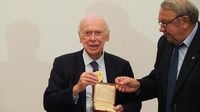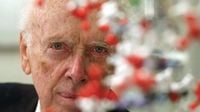James D. Watson, the American biologist whose co-discovery of the double-helix structure of DNA in 1953 revolutionized science and medicine, has died at the age of 97. Watson passed away in hospice care on Long Island after a brief illness, his family confirmed on November 6, 2025, according to The Associated Press and Reuters. His death marks the end of an era for genetics, closing the chapter on a life that was both celebrated for its scientific achievements and shadowed by controversy in later years.
Born in Chicago on April 6, 1928, Watson was a precocious child who entered the University of Chicago at age 15 and graduated at 19. By 23, he had earned a doctorate in zoology from Indiana University. His early fascination with genetics was sparked by a book he read at 17, which described genes as the essence of life. "I thought, 'Well, if the gene is the essence of life, I want to know more about it,'" Watson later recalled, as reported by The Associated Press.
Watson’s life changed forever in the fall of 1951 when he arrived at Cambridge University’s Cavendish Laboratory. There, he met Francis Crick, and together they began the quest to unravel the structure of DNA. The partnership, described by Watson’s biographer as "intellectual love at first sight," thrived on shared ambition and impatience with sloppy thinking. Their breakthrough came in 1953, aided by crucial X-ray data from Rosalind Franklin and Raymond Gosling, as well as insights from Maurice Wilkins and colleagues at King’s College London.
Their model—two intertwined strands forming a twisting ladder—instantly suggested how hereditary information is stored and duplicated. As Watson and Crick wrote in their landmark paper, "It has not escaped our notice that the specific pairing we have postulated immediately suggests a possible copying mechanism for the genetic material." That understated sentence, now famous in scientific circles, hinted at the molecular basis for inheritance and laid the groundwork for genetic engineering, gene therapy, and DNA-based forensics.
Watson, Crick, and Wilkins were awarded the Nobel Prize in Physiology or Medicine in 1962 for their discovery. The double helix became a universal symbol of science, finding its way into art, pop culture, and even British postage stamps. According to Fox News Digital, Cold Spring Harbor Laboratory, where Watson spent much of his career, called the discovery "a pivotal moment in the life sciences." Watson himself once quipped, "Francis Crick and I made the discovery of the century, that was pretty clear."
Despite the scientific triumph, Watson’s legacy is complicated. His 1968 memoir, "The Double Helix," offered an unvarnished account of the race to discover DNA’s structure, drawing criticism from colleagues for its candid portrayal of ambition and rivalry. Maurice Wilkins objected to the depiction of scientists as schemers, while Crick complained that the book "grossly invaded my privacy." Watson and Crick were also criticized for not fully acknowledging Rosalind Franklin’s contributions, a point that has since become emblematic of the challenges faced by women in science.
Watson’s influence extended far beyond the laboratory. After stints at the California Institute of Technology and Harvard University—where he helped establish a world-class molecular biology program—he became director of Cold Spring Harbor Laboratory in 1968. There, he transformed a "mosquito-infested backwater," as biologist Mark Ptashne described it to Reuters, into a vibrant center for genetics research. Watson also played a key role in launching the Human Genome Project in 1990, a monumental effort to map the entire human genetic code. He insisted that the results remain in the public domain, resigning in protest when the National Institutes of Health sought patents on DNA sequences.
Watson’s personal motivations were never far from his work. His son Rufus’s struggles with mental illness fueled his interest in understanding the genetic basis of disease. He was present at the White House in 2000 for the announcement of a "working draft" of the human genome, and in 2007, he became one of the first individuals to have his genome sequenced.
Yet, in his later years, Watson’s reputation suffered due to inflammatory remarks about race and intelligence. In 2007, he told the Times of London that he was "inherently gloomy about the prospect of Africa" because "all our social policies are based on the fact that their intelligence is the same as ours—where all the testing says not really." He apologized, but the backlash was swift. Cold Spring Harbor Laboratory suspended him from his role as chancellor, and he retired soon after. In 2019, after reiterating similar views in a documentary, the lab revoked his honorary titles, calling his statements "reprehensible" and "unsupported by science." As The Associated Press noted, Dr. Francis Collins, then-director of the National Institutes of Health, lamented that Watson’s "outbursts, particularly when they reflected on race, were both profoundly misguided and deeply hurtful."
Watson’s controversial opinions on genetics and society were not limited to race. He once suggested that sex drive was linked to skin color and argued that women should be allowed to abort fetuses found to carry genes associated with homosexuality. Despite these views, some colleagues, including MIT’s Nancy Hopkins, acknowledged his support for women in science, noting the contradiction between his public statements and personal encouragement.
Throughout his life, Watson relished his "bad-boy" image, as friends described it, and delighted in stirring debate. He auctioned his Nobel medal in 2014 for $4.7 million—a record at the time—only for the medal to be returned to him by the buyer. Watson’s co-discoverers, Francis Crick and Maurice Wilkins, both died in 2004, leaving him as the last living member of the trio that changed biology forever.
In the end, Watson’s own words perhaps best capture the arc of his career: "There was no way we could have foreseen the explosive impact of the double helix on science and society." For better or worse, James D. Watson’s life and work have left an indelible mark on the world—one that will be debated, studied, and remembered for generations to come.





